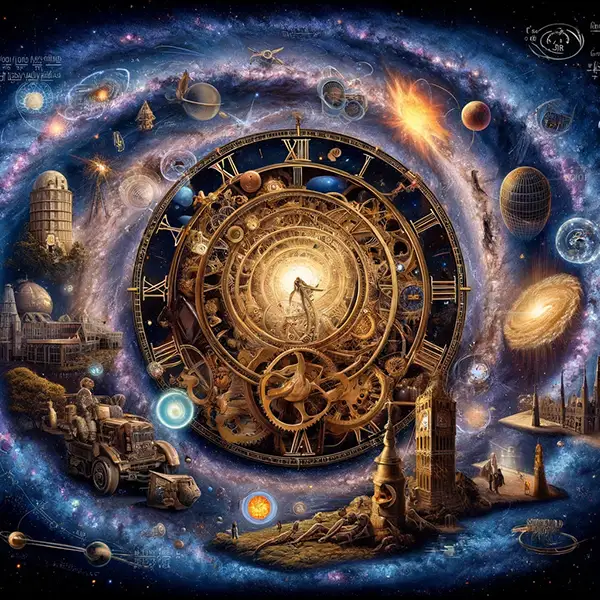5.4 Time is Not an Illusion

Spacetime
Strange ideas about time abound in physics. However some are well established and now universally accepted.
The rate at which time passes, in the everyday sense, seems to us invariant. One second as measured by a single highly precise atomic clock will be the same as another measured by the same clock no matter how fast or slow the observer and her clock are moving. However the situation is measurably more complex when two highly precise atomic clocks are in motion with respect to each other. The rate at which time passes will differ between the two clocks as predicted by Einstein’s Theory of Special Relativity. The theory includes the concept of time dilation for observers moving with respect to one another. In other words if I could counterfactually observe the watch of an astronaut travelling close to the speed of light, time on her watch would appear to run much more slowly for me.
It is mathematically convenient and predictively useful to consider that space and time are best described by the hyperbolic space-time geometry of Minkowski in which the 3 spatial dimensions and time are combined into a 4-dimensional topological manifold. In this physics the projection of a worldline travelled by one moving observer when counterfactually viewed by another observer on a different worldline would result in observable Lorentz transformations of both space and time (combined). This explanation can be easily grasped with 2D space time diagrams, in which only one spatial dimension x (squared) is plotted against ct (squared), where ‘c’ is the speed of light in a vacuum, from the relativistic perspective of an observer.
Despite the mathematical convenience of ‘spacetime’ for the “shut up and calculate” view of physics, in which the mathematical formulae represent our foundational understanding, we cannot abandon the related deeper philosophical or ontological questions about what exists. Should we really see time and space as having a metaphysical equivalence in some way? We can traverse space and make a return journey within the same frame of reference. However the same consideration does not apply to time. The second law of thermodynamics suggests we travel relentlessly forward in time but never backwards. The time component of spacetime is in some way different from the spatial dimensions in which we move.
Illusion? One step too far
In a very stimulating public lecture by Carlo Rovelli, who was one of the originators of loop quantum gravity theory, asks us to believe that time is an illusion and he is not alone in doing so. This is despite that in our everyday experience, we normally take it completely for granted that our conception of time is correct or at least useful. Are we to believe that the past present and future all exist at the same time in a ‘block universe‘ or that the past and present exits in a growing block universe?
Worse still he expects us to believe that we are merely emotionally wedded to the idea of time. Time, we are told, by Rovelli does not ‘really’ exist in the sense that we commonly accept.
This is despite the very obvious alternative view that time seems be is a crucial explanatory ‘primitive’ in every event or process that has happened in your life and every scientific observation that has been made related to the history of the universe since the Big Bang, the formation of heavy atoms in cycles of star formation, the existence of chemical reactions, the second law of thermodynamics, radio-nucleotide half-life, and all of biology and evolutionary theory. Any understanding of ourselves or the universe requires us to understand macroscopic processes, which by definition occur in time. The requirement for time appears at almost every level of explanation that does not invoke quantum states.
When very strange claims are made that defy our everyday experience and much of science that should start alarm bells ringing for any pragmatist. I believe we should be extremely sceptical of all claims that seek to undermine extremely well-established and pragmatically valuable concepts.
By contrast, Lee Smolin has elaborated the idea we should not let mathematics over dominate our thinking ” … (mathematics) is very powerful, but it is so powerful that we begin to make a mistake and imagine that nature is mathematics and then because something is true in mathematics it is always true. There is a sense in which mathematics is timeless .. is time free. So we begin to unconsciously import the timeless of mathematics into our conceptions of nature.” (see source) As argued in previous sections, mathematical descriptions (or laws) in science emerge from the axioms, not the other way round.
In an award-winning paper entitled, ‘The Universe as a Process of Unique Events‘ by Marina Cortˆes and Lee Smollin have possibly come to our rescue with a more philosophically well-embedded view of time. (Smolin was one of the originators and collaborators of Rovelli in the development of loop quantum gravity and describes him as a friend of Rovelli). Cortˆes and Smollin have provided both a philosophical setting and a highly mathematical case (that is unintelligible to me) in support of the idea that we should regard time as progressive or flowing between events and a necessary ‘primitive’ (or axiomatic) concept. What a surprise! Whether or not the new way of looking at things it will be accepted academically in the long run is largely dependent on the potential of the theory to generate observationally or experimentally testable predictions. Eventually the most wayward members of the current academic community might be able to catch up with the rest of us.
Version 1.1
Steve Campbell
Glasgow, Scotland
2022
< previous | Index | next available section >